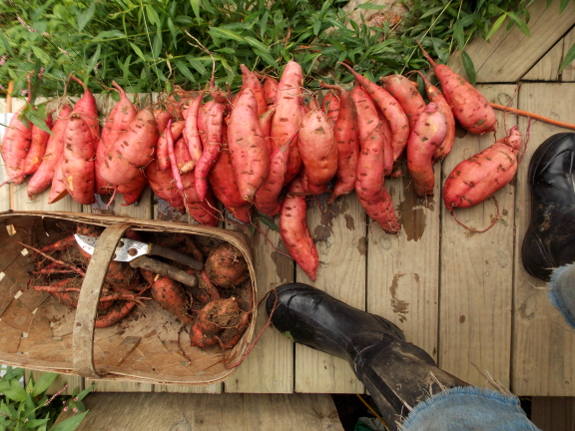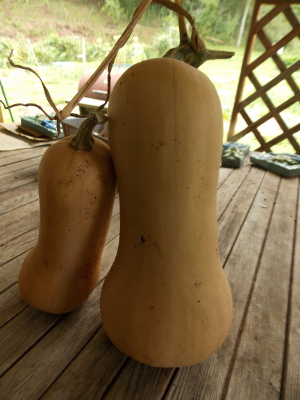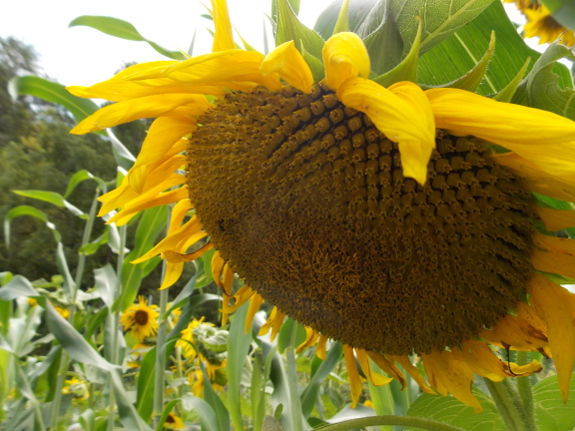
Vegetables that thrive in poor soil

 I
had forgotten how poor our soil used to be until I opened up some new
garden areas this year. Without frequent applications of manure,
straw, and cover crops
to build the organic-matter levels, our native soil is a cloddy mass of
pale silty-clay. Unsurprisingly, many crops failed to thrive in
this new ground...but others did even better. I figured you might
like hearing about the good and the bad in case you have poor-soil areas
of your own that you want to put into production now rather than
waiting until years of TLC turn your topsoil black.
I
had forgotten how poor our soil used to be until I opened up some new
garden areas this year. Without frequent applications of manure,
straw, and cover crops
to build the organic-matter levels, our native soil is a cloddy mass of
pale silty-clay. Unsurprisingly, many crops failed to thrive in
this new ground...but others did even better. I figured you might
like hearing about the good and the bad in case you have poor-soil areas
of your own that you want to put into production now rather than
waiting until years of TLC turn your topsoil black.
Who failed the
test? Carrots and butternuts both grew in the new ground, but
produced fruits and roots that were half the size of what I'm used
to. In the photo, the butternut on the right comes from an older
bed while the one on the left is representative of the squash we
harvested from the new bed. Total yield in the new ground was
about a third to a quarter of what I'd expect elsewhere for these two
crops.

On the other hand,
sunflowers and sweet potatoes seemed to grow even better in the poor
soil. In the top photo, the potatoes in the basket all came from a
similar square footage (but from richer soil) as the huge number of
potatoes cleaned and stacked on the porch (that came from poorer
soil). Keep in mind that I did take the time to dig these new patches,
scooping the topsoil out of the aisles to double the height of the
growing beds (and I usually don't dig or till our established beds at
all). So, the thrivers may be responding to the fluffiness and
quick breakdown of organic matter into nitrogen that you find in
recently churned ground. Or maybe they just like low organic
matter and nutrient levels.
To paraphrase Tolstoy,
happy soils are all alike; every unhappy soil is unhappy in its own
way. So you might find that the crops that thrive in our poor soil
don't do so well in yours. Still, I'd be curious to hear from our
readers who have kept an eye on crops growing in good and poor parts of
their gardens. Which plants like and dislike the bad ground?
Want more in-depth information? Browse through our books.
Or explore more posts by date or by subject.
About us: Anna Hess and Mark Hamilton spent over a decade living self-sufficiently in the mountains of Virginia before moving north to start over from scratch in the foothills of Ohio. They've experimented with permaculture, no-till gardening, trailersteading, home-based microbusinesses and much more, writing about their adventures in both blogs and books.
Want to be notified when new comments are posted on this page? Click on the RSS button after you add a comment to subscribe to the comment feed, or simply check the box beside "email replies to me" while writing your comment.

I tried to persuade a few beets to grow in poor ground, and they were NOT interested. But our new fig doesn't seem to mind.
Incidentally, if you like Tolstoy, check out today's Google search engine.
Hm I think I'd be happy with a bit of that silty clay ... my soil is 100% sand ... speaking of poor..
 However, how low in minerals and organic stuff my soil is, there's some good things, it heats up easily, it's easy to work, I think every soil has it goods and bads, as long as it is the original stuff and not some junk from a building area or so
However, how low in minerals and organic stuff my soil is, there's some good things, it heats up easily, it's easy to work, I think every soil has it goods and bads, as long as it is the original stuff and not some junk from a building area or so
Your flowers are amazing! love your blog!!